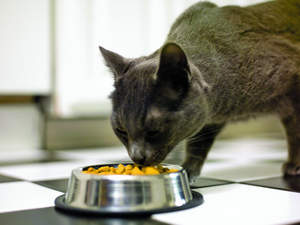MISSION, KS--(Marketwire - Nov 26, 2012) - (Family Features) Obesity and being overweight are human health problems that get a lot of attention from doctors and the media. What hasn't gotten as much attention is the fact that many pets are suffering from the very same problems. The Association for Pet Obesity Prevention estimates that 88.4 million U.S. dogs and cats -- 54 percent -- are overweight or obese. And that can lead to health problems such as arthritis, diabetes, heart disease and even some cancers.
Many pet owners aren't aware that their pets are overweight. A study from the U.S. Food and Drug Administration's Center for Veterinary Medicine found that 22 percent of dog owners and 15 percent of cat owners described their pets as being normal weight, when they were actually overweight or obese.
What's a little extra weight for your pet? A lot more than it is for you:
- Just two pounds of extra weight on a Chihuahua would be equivalent to more than 60 additional pounds on an adult human.
- Even just four pounds too many on a 10-pound Siamese cat would be equivalent to almost 40 extra pounds on a human.
Signs Your Cat is Overweight:
- Is it difficult to feel her ribs or spine?
- Is it difficult to see your cat's waist?
- Is her abdomen sagging?
Does your cat:
- Often appear tired and lazy?
- Hesitate when jumping onto furniture?
- Have difficulty grooming properly?
- Have matted hair on the back or tail area?
- Resist playing games?
Signs Your Dog is Overweight:
- Is it difficult to feel his ribs or spine?
- Is it difficult to see your dog's waist?
- Is his abdomen sagging?
Does your dog:
- Often appear tired and lazy?
- Lag behind on walks?
- Pant constantly?
- Need help getting in the car?
- Resist playing games?
- Bark without getting up?
What You Can Do
Adjust some of your feeding habits to help your dog or cat lose weight or maintain a healthy weight.
- Avoid feeding table scraps and snacks.
- Stick to the recommended daily feeding guide. You may want to weigh out the amount at the beginning of the day, to avoid accidental overfeeding
- Divide the daily allowance into several meals for the most efficient weight loss.
- Keep your pet in another room when preparing or eating your own meals.
- If you have several pets, feed them separately.
- Don't leave any food lying around.
You also need to make sure your pet is getting adequate exercise.
Talk to Your Vet
It's important that you discuss your pet's weight and nutrition with your vet. Ask questions such as:
- What is the target weight for my pet?
- What are the health risks if my pet is overweight?
- What exercise program should I follow to help my pet reach target weight?
- Is there a therapeutic food you can recommend for my pet's health?
- How much and how often should I feed my pet?
- What appropriate treats are recommended for my pet?
- How many treats can I give?
- Can you provide written instructions or a booklet for weight management?
- What can I do to help my pet get more exercise?
For more tips and tools to help keep your pets at a healthy weight, visit www.petfit.com.
About Family Features Editorial Syndicate
This and other food and lifestyle content can be found at www.editors.familyfeatures.com. Family Features is a leading provider of free food and lifestyle content for use in print and online publications. Register with no obligation to access a variety of formatted and unformatted features, accompanying photos, and automatically updating Web content solutions.
Contact Information:
Matthew Barksdale
mbarksdale@familyfeatures.com
1-888-824-3337
http://editors.familyfeatures.com
